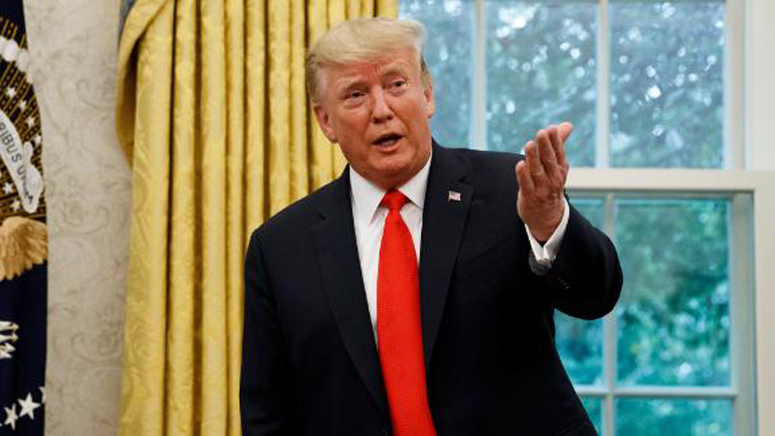(CNN) — President Donald Trump is reviving last year’s promise to slash taxes for America’s middle class as he seeks to bolster his reelection bid against Democratic pledges to help people suffering under piles of student loan debt and wrestling to pay oversized medical bills.
Speaking in Baltimore on Thursday night, Trump promised — yet again — his administration would announce new tax cuts next year, claiming they would be “very, very substantial,” without offering any more details.
“We’re working on a tax cut for the middle-income people that is going to be very, very inspirational,” said Trump, who took the stage at the exact time Democratic presidential candidates were lining up in Houston for their third debate. “It’s going to be something that I think everyone is looking for.”
The fresh commitment by the President was reminiscent of a pledge he made last October ahead of the midterm elections, when he announced a mysterious last-minute middle-class tax that puzzled White House officials, congressional leaders and tax wonks in Washington.
Top aides have echoed the message, while making clear there’s no agreement on a plan.
“We are going to go through with what I call ‘Tax Cuts 2.0,’ and I say that because I spoke with the President at some length about this idea,” National Economic Council director Larry Kudlow said Friday. “We will gather together the best ideas from the Hill and the administration and outside folks to provide a significant new round of middle-class tax relief. This is not a recession measure at all, because I think the economy is very strong. Probably might put something out sometime maybe the middle of next year. That kind of thing. So Tax Cuts 2.0 is where we’re headed.”
Those comments came after Treasury Secretary Steven Mnuchin said Thursday that the White House was looking into rolling out a so-called “Tax Cuts 2.0” plan at the beginning of next year that would aim to spur economic growth through potential tax cuts and incentives for small- and medium-sized businesses and help for the middle class as part of the package.
“Unlike his competition, the President wants to grow the economy and make sure that we have tax cuts for the middle class and that they benefit,” Mnuchin said in an interview on CNBC on Thursday, a day after officials had met in the Oval Office to discuss various tax proposals as fears mount that Trump’s reelection campaign could be upended by a possible economic downturn.
Democrats vying for Trump’s job are proposing major new government spending programs, largely funded by tax increases on the rich. Their proposals have ranged from repealing the 2017 tax law to undoing the cuts for the wealthiest to removing certain provisions that benefit corporations.
Since August, the Trump administration has been wrestling with how to recession-proof the US economy, swinging from one idea to the next even as it has brushed off any fears of a looming recession that may be ill timed as voters head to the polls in November 2020.
Senior White House officials have looked at a range of proposals to keep the US economy moving, everything from giving workers a pay bump by cutting payroll taxes to cutting capital gains taxes for investors. But officials have put those proposals on hold for the time being, since they would face the political risks of deploying yet another tax break that would benefit the wealthy — a regular talking point Democrats use when it comes to Trump’s 2017 tax law.
The discussions inside the administration come as the budget deficit has ballooned past $1 trillion, driven partly by the tax cuts Trump signed into law.
Instead, the President’s strategy appears — for now — to be focused on steps the administration can take that would benefit average working Americans, a fresh push for final passage of the new North American free trade agreement and more pressure on the Federal Reserve to cut interest rates.
Trump has sought to downplay the risk of a recession while pinning blame for a potential downturn on the Fed. This week he called on the central bank, an institution independent from the White House, to cut interest rates to zero or even drift into negative territory.
That’s much more than the White House had asked the Fed to do a few weeks earlier in calling for at least a 100 basis point cut over a period of time.
The President has repeatedly chastised the Fed, accusing it of weakening US competitiveness by not lowering interest rates faster and going so far as to call officials “Boneheads.”
“The USA should always be paying the lowest rate,” he tweeted on Wednesday, while criticizing his own chairman, Jerome Powell, “It is only the naiveté of Jay Powell and the Federal Reserve that doesn’t allow us to do what other countries are already doing.”
The US economy appears — at least for now — to be chugging along, with growth at 2.1%. Wages for workers have grown. Unemployment remains at a historic 50-year low. And consumers are still spending at a good clip at their favorite retailers.
Concerns about a slowdown and an eventual general recession have increased since the beginning of August as the chances of a trade deal with China have ebbed and flowed. Several major countries have reported poor growth, with Germany’s economy contracting slightly. Several market indicators are blinking red, with the yield curve on US bonds (briefly) inverting last week for the first time since the prerecession year of 2007.
Central bankers are set to meet next Wednesday, and have signaled they may cut rates again to help bolster the economy from headwinds caused by the Trump administration’s erratic trade policy.
(Copyright (c) 2024 The Associated Press. All Rights Reserved. This material may not be published, broadcast, rewritten, or redistributed.)

